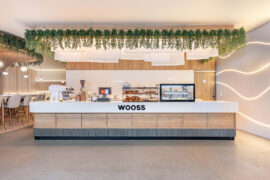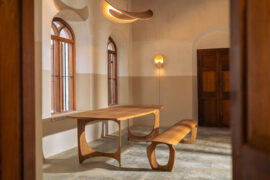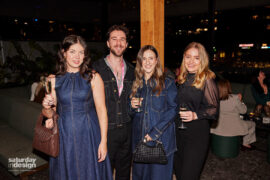Rosie Morley, principal at Fender Katsalidis, discusses the pertinence of human-centred design and tantalising the senses in the mission to create transformative environments.

Midnight Hotel, Fender Katsalidis. Photo by Ryan Linnegar
February 3rd, 2021
When it comes to creating transformative environments, designing experiences should come first. It is a fundamental part of achieving cohesive spaces and memorable interiors. The first step in this process is setting up a framework for the desired human experiences that we want to evoke.
How one approaches and the way they depart are among the most important aspects to consider in design. This ‘arrivals and departures’ methodology isn’t merely an aesthetic – it’s about curating how a space should feel, crafting an immersive, engaging and tactile quality that adds a certain grit or depth.

With so much of our time spent inside our homes this past year, plus the extra attention now spent thinking about surfaces in public environments, more than ever, this idea of experiencing a space has heightened to a new level of hypersensitivity.
If what we remember most about a physical environment is the sensory aspects, we must contemplate all that one might smell, hear, touch and engage with in order to connect through experiential design. Immersive spaces like Mona in Hobart do this best by instinctively considering how to make people experience emotion through design. The most successful outcomes are those which are responsive to the user’s wants and needs, leaving them satisfied on a deeper level. Spaces that are inviting, engaging and worthy of our time have a way of staying with us long after.

Midnight Hotel, Fender Katsalidis. Photo by Ryan Linnegar
Working with our client, it is our responsibility as designers to unlock possibilities and break new ground. We must always be looking to evolve our process and set the next benchmark. Fundamental to this is finding what’s special to the site and what makes it unique. So, when tasked with a brief, the response needs to be something of an anti-look-and-feel document. Immersive workshops build trust and set up the expectation that we as designers are always fighting for the best experiences. That’s achieved through a range of tools which the team utilises to consider words, concepts and visual language first.

Catering to the end user, the closer we get to them, the better. Understanding the user’s mindset and how they will receive this experience is an ongoing relationship. Figuring out how you want people to move, and in turn how to move people, comes from a place of rigorous research. Given everything is assessed virtually now, engagement that is intended to be emotional often happens first on-screen. As designers, our skill lies in being able to unpack what users are thinking and feeling in order to get it right.
Since our discipline is elastic, what we do is never static. As idea generators, trusted advisors, and design polyglots, we are constantly reframing and reinventing a language and tone of voice that compels people to think and feel. To achieve this, we must keep finding new ways to be experience-driven and human-centred.
Rosie Morley is a newly appointed principal at Fender Katsalidis. In her mission to create cohesion between the external and internal, she manages to blur the lines between them in rewarding and unexpected ways.

INDESIGN is on instagram
Follow @indesignlive
A searchable and comprehensive guide for specifying leading products and their suppliers
Keep up to date with the latest and greatest from our industry BFF's!

For Aidan Mawhinney, the secret ingredient to Living Edge’s success “comes down to people, product and place.” As the brand celebrates a significant 25-year milestone, it’s that commitment to authentic, sustainable design – and the people behind it all – that continues to anchor its legacy.

A curated exhibition in Frederiksstaden captures the spirit of Australian design

Angela Biddle, Principal and interior designer at multi-disciplinary international design firm FK, comments on how hotel design is evolving.

Adaptive reuse is all the rage across the design industry, and rightly so. Here, we present a selection of articles on this most effective approach to sustainability.

Overcoming pandemic hurdles to redefine guest experiences amidst Sydney’s bustling entertainment precinct, The Darling has undergone a two-year restoration that melds Art Deco interiors with the necessities of hotel living.
The internet never sleeps! Here's the stuff you might have missed

Serving up the perfect dessert is about more than what’s in the crockery, it is also about cultivating an ambient, immersive setting that enhances the treats.

Sub-Zero Wolf Kitchen Design Contest (KDC) announces the remarkable Arizona Biltmore as the location of the 2026 Gala Venue and Winners’ Summit

From Australian architects to Spanish and Indian designers, Design Mumbai 2025 expands its international reach — proving India’s growing role on the global design stage.

On 6th September 2025, Saturday Indesign went out with a bang at The Albion Rooftop in Melbourne. Sponsored by ABI Interiors, Woodcut and Signorino, the Afterparty was the perfect finale to a day of design, connection and creativity.